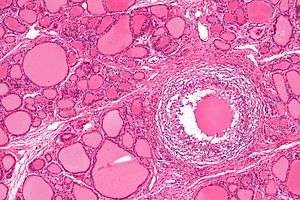De Quervain's thyroiditis
| De Quervain's thyroiditis | |
|---|---|
 | |
| Micrograph showing a granuloma in subacute thyroiditis. H&E stain. | |
| Classification and external resources | |
| ICD-10 | E06.1 |
| ICD-9-CM | 245.1 |
| DiseasesDB | 3474 |
| MedlinePlus | 000375 |
| eMedicine | med/534 |
| MeSH | D013968 |
De Quervain's thyroiditis, can also be known as subacute granulomatous thyroiditis or giant cell thyroiditis. Males and females of all ages may be affected. It is a member of the group of thyroiditis conditions known as resolving thyroiditis.
Terminology
It is sometimes called subacute thyroiditis,[1] but there are other forms of subacute thyroiditis, subacute lymphocytic thyroiditis, post partum thyroiditis, and autoimmune thyroiditis all of which, in contrast to de Quervain's, are typically painless or "silent".
It is also sometimes called "painful subacute thyroiditis".[2] This is in contrast to subacute lymphocytic thyroiditis, which is also sometimes called "painless thyroiditis".
Causes
Some cases may be viral in origin, perhaps preceded by an upper respiratory tract infection. Viral causes include Coxsackie virus, mumps and adenoviruses. Some cases develop postpartum .
Presentation
Patients will experience a hyperthyroid period as the cellular lining of colloid spaces fails, allowing abundant colloid into the circulation, with neck pain and fever. Patients typically then become hypothyroid as the pituitary reduces TSH production and the inappropriately released colloid is depleted before resolving to euthyroid. The symptoms are those of hyperthyroidism and hypothyroidism. In addition, patients may suffer from painful dysphagia. There are multi-nucleated giant cells on histology. Thyroid antibodies can be present in some cases. The clinical presentation during the hyperthyroid phase can mimic those of Diffuse Toxic Goiter or Graves' disease. In such cases, a radionuclide thyroid uptake and scan can be helpful, since subacute thyroiditis will result in decreased isotope uptake, while Graves' disease will generally result in increased uptake. Distinguishing between these two types of disease is important, since Graves' disease and Diffuse Toxic Goiter can be treated with radioiodine therapy, but subacute thyroiditis is usually self-limited and is not treated with radioiodine.
Treatment
Treatment is beta blockers and NSAIDs (or corticosteroids if NSAIDs are ineffective).
Eponym
It is named for Fritz de Quervain.[3] It should not be confused with De Quervain syndrome.
References
- ↑ Topuzovic N, Smoje J, Karner I (October 1997). "The therapeutic approach in subacute (de Quervain's) thyroiditis". J. Nucl. Med. 38 (10): 1665. PMID 9379217.
- ↑ Peter SA (October 1992). "Painful subacute thyroiditis (de Quervain's thyroiditis)". J Natl Med Assoc. 84 (10): 877–9. PMC 2571803
 . PMID 1404465.
. PMID 1404465. - ↑ synd/1139 at Who Named It?